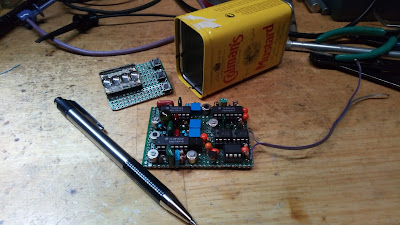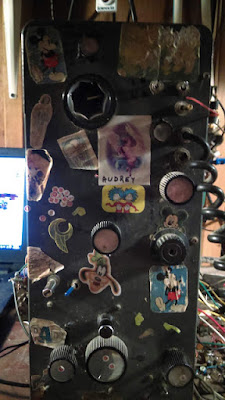Keith N6ORS is a prolific homebrewer and a frequent contributor to the SolderSmoke blog. Many of you will remember his MINEX rig. And who can forget his SDR creation, called (by him!) "Satan's Digital Radio"? Well, Keith is at it again, this time working on a phasing rig.
HI Bill,
Its been a while. Lately I've been working on a phasing transceiver73,
A while back I did a little diagram that -- for me -- explains how phasing cancels one of the sidebands. It appears below. I think Keith's board is for the 90 degree audio phase shift. You can see how, by changing the shift from you can affect the degree of sideband suppression. I guess by going from -90 to +90 you could completely switch sidebands.
This diagram shows a direct conversion receiver with the VFO tuned to 7200 kHz. There is a signal at 7202 kHz and another signal at 7199 kHz. In a simple direct conversion receiver, BOTH these signals would produce audio tones in the receiver output. You'd hear both a 2 kHz tone and a 1 kHz tone. Assume you only want to hear the 1 kHz tone resulting from the 7199 kHz signal. Phasing lets you do this. Here's how:
-- First split the VFO signal into its "normal" output and an output that lags by 90 degrees (-90)
-- Consider the output from the top (normal) mixer to be your reference signal.
-- Because of the lag in the VFO signal going to the bottom mixer, the output from the bottom mixer will have the 1 kHz signal 90 degrees ahead of the reference signal (+90) while 2 kHz tone will be 90 degrees behind the reference signals (see "scope view") above. This is a consequence of the mixer math.
-- Now, in the bottom signal path, shift BOTH audio tones by -90 degrees (in relation to the top reference signal). I think this is what Keith's board is doing.
-- With this -90 degree shift, the 1 kHz signal on the bottom path will be IN PHASE with the 1 kHz signal at the top. But the 2 kHz signal in the bottom path will be 180 degrees OUT OF PHASE with the (top) reference signal path.
-- The two signal paths are combined before going to the audio amplifiers. The 1 kHz signal is reinforced while the 2 kHz signal is "nulled out."
The same principle can be used on transmit. Instead of two receive mixers, you have two balanced modulators. Both are putting out upper and lower sidebands. Instead of the VFO you have the carrier oscillator. By using the same phase shifting techniques you can reinforce one of the transmitter's sidebands while nulling out the other.




























.jpg)









